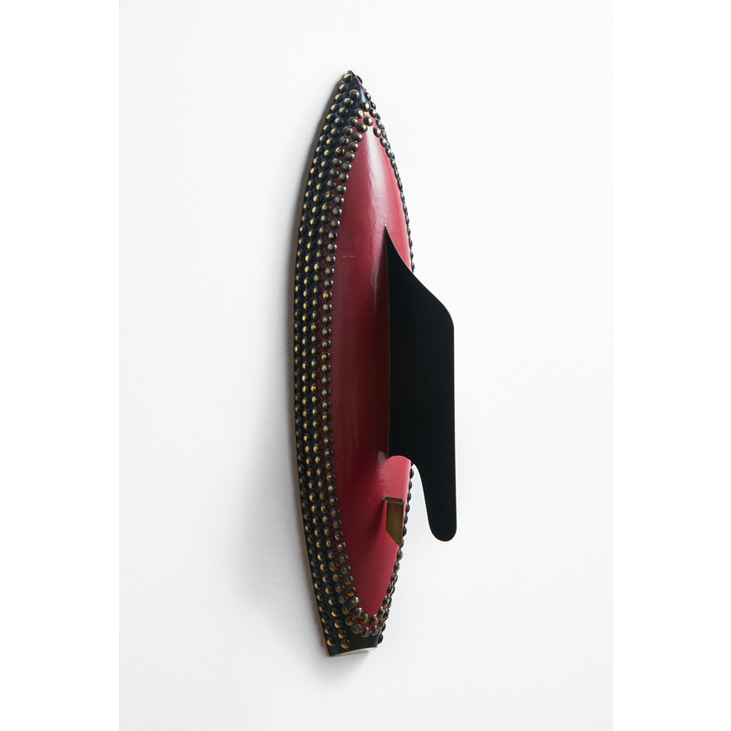"Interesting things happen on the edge." | An Interview with LR Vandy
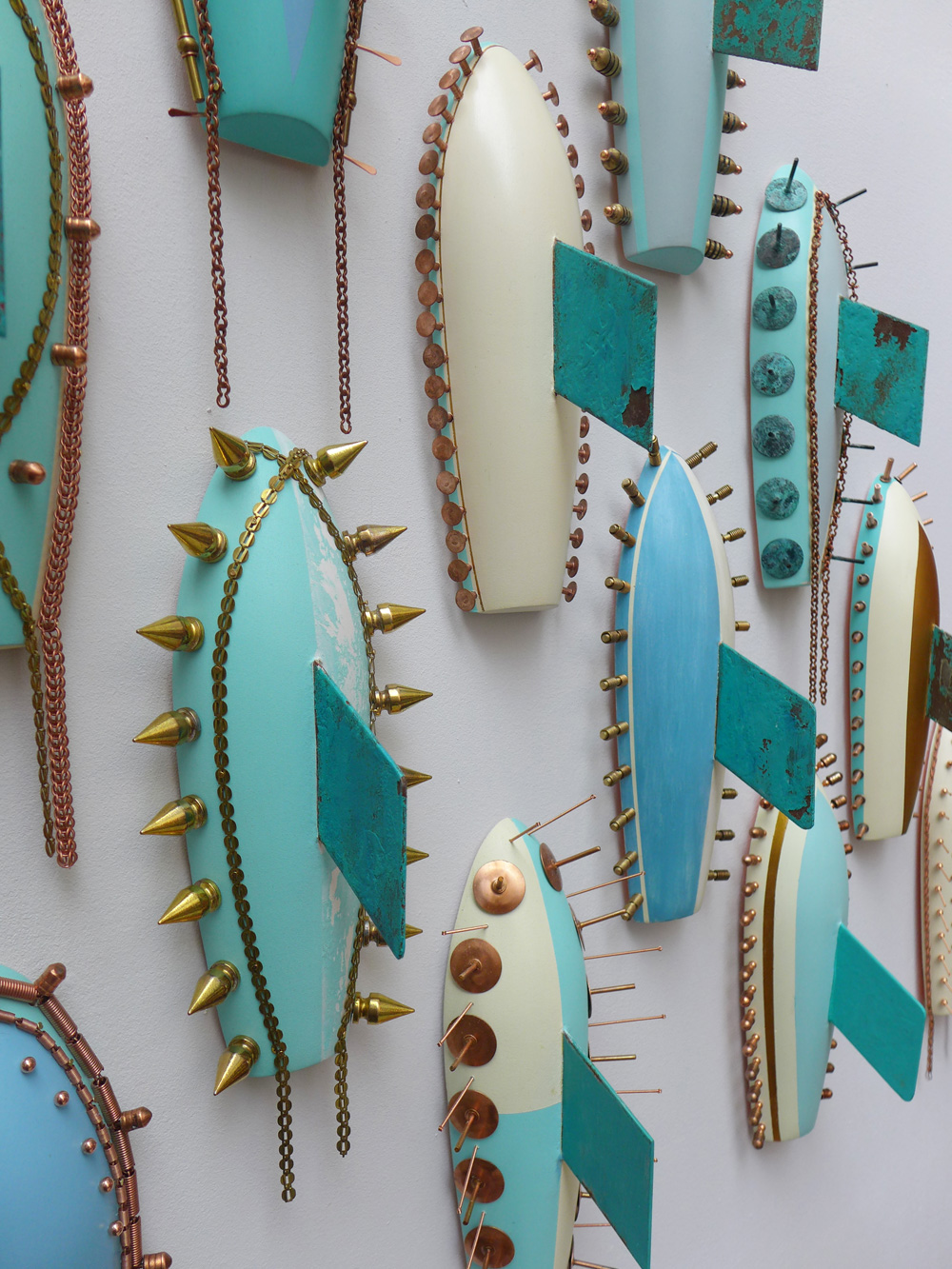
Close-up: 'Heavy is the Head That Wears the Crown' installation
A few years back British artist LR Vandy was rummaging around a car boot sale and came across the old hull of a model sailboat. Turning it over in her hands she noticed the underside looked like an African mask. A maker all her life, she knew she wanted to do something with it. Today she’s most well-known for the many hulls she’s stripped, painted and embellished with anything from metal spikes to horse hair. The beautiful, precious objects are a lure of sorts for considering painful subjects of migration; historically through the Atlantic slave trade and currently the many people making desperate, treacherous boat journeys in hopes of a safer life. The romance of sail boats is thrown into uncomfortable contrast with exploitation and trafficking. Inspired by her Nigerian heritage, Vandy sees the masks as guardians.
Vandy’s first ever exhibition of these works was in 2018 with October Gallery at 1-54 Contemporary African Art Fair in London. It was a sell-out show. Her first sale in the art world was to the British Museum.
Transformed by Vandy, each hull contains suggestions of her previous careers as a jewellery designer — she created pieces for John Galliano and did all the jewellery for the David Bowie film, Labyrinth — a set designer for major televised events like the MTV Awards, and a furniture design graduate.
Alongside her sought-after hull artworks, Vandy produces larger scale pieces like her sculpture Superhero Cog Woman which will be on show in Kensington this summer. “There aren’t enough sculptures of women in any city anywhere,” she’s said.
Vandy is generous when talking about her work and laughs often. ““There’s got to be humour,” she’s said before. “It’s too painful otherwise.” We chatted about what her previous lives add to her art, if she’ll keep making hulls and people’s sometimes hilarious interpretations of her work.
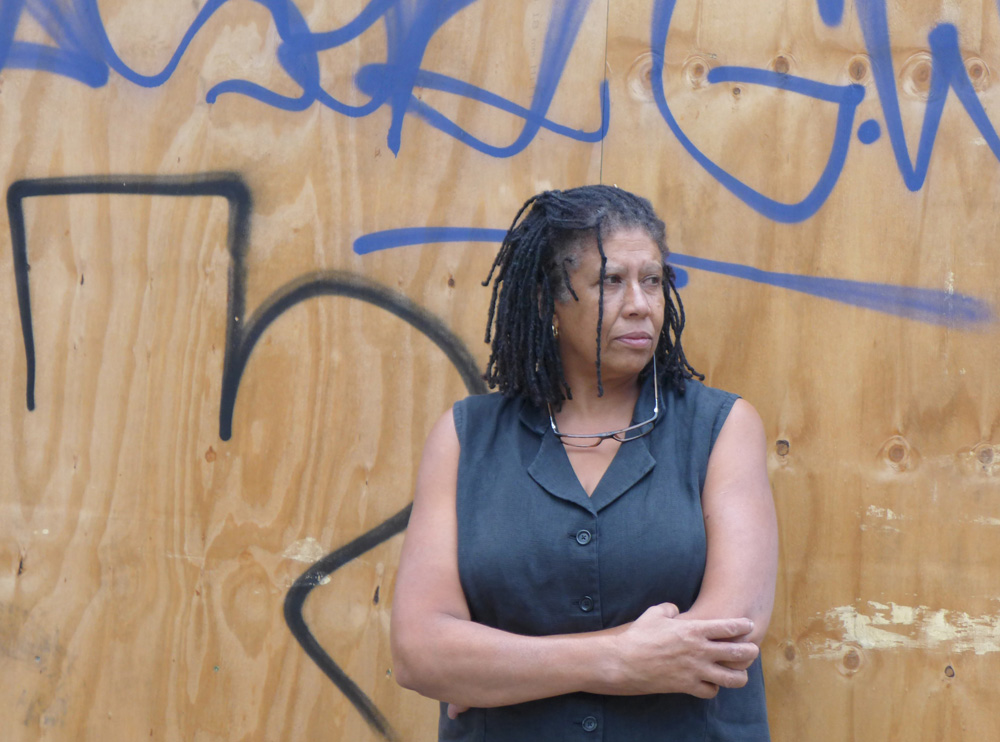
Can I ask why you go by LR instead of Lisa?
Because I was a production designer in television and commercials and live events so I had a website with my name Lisa Vandy on it and I wanted to make a new identity as an artist. I was quite interested in it being gender-free in a way. I remember when we were young, it was very fashionable to always have a Penguin book in your pocket and in those days the authors were always R.S. this and D.W. that. I thought that would be great because no-one would know whether I was male or female. I like the idea of people not knowing who the work’s made by because people do have biases, I’m afraid. It’s quite nice to feel free looking at something not knowing.
When did you first become interested in making African masks? You’ve mentioned the masks being guardians.
Yes that’s how I see them. I make other types of work as well, obviously. But it was coming across a boat hull in a car boot sale. To me it looked like an African mask. It just had it all. But that sat with me for probably two years before I actually did something with it. I found it very exciting. But also it’s important for me that there’s some sort of tension there.
Yes, I’m interested in how you use beauty. When you’re transforming boat hulls into masks, do you do this to turn something devastating into something beautiful and meaningful or do the beautiful objects rather draw people in and then they’re met with the meaning of the works which address challenging topics?
It’s probably the latter, once you’ve drawn people in they have to start questioning. Once they’re in, they’re in, aren’t they? And then they can start their own thoughts and travels in their heads around it all. But yes I think it’s a useful tool to draw people in to talk about larger and slightly more challenging subjects.
Claret and Brass, Wood and metal, 2019. Presented by October Gallery. ENQUIRE.
What keeps you making more hull artworks? What keeps you interested in it?
I’m a maker, I love to make, I think it’s human. I think we have these amazing hands and when we make we feel good. I can’t stop making them, the subject is still worth exploring. We’re talking about slavery and it doesn’t have to be 18th/19th century slavery, we still have slavery today. All my work is motivated politically. I feel it’s important that women’s voices are out there all the time, the power of women’s voices is recognised. But I also like to talk about transportation, I have railway pieces as well, because I think again this is a place where the sort of underbelly of life is hidden, isn’t it? I really am showing you the underbelly of the hull because that’s the bit you never see.
And it’s definitely not something that will be neatly wrapped up in one series and that’s that.
No! That’s a good point. It’s a forever subject, absolutely. Listen if people keep wanting them, I will keep making them for sure. As long as I can keep making other pieces. It’s just what I do now, I just go to the studio and that’s what I do! It’s like a compulsion, I’m afraid.
Would you ever make the hulls yourself or do they lose meaning if they’re not used before?
I can get hulls built or made but there’s no need. They’re still out there. I have a dealer who deals in model boats but he says it’s really drying up now. But I’ve got a big collection. Some of them are 6 feet high so I buy what I can and store them in a container. But they’re beautiful objects. You couldn’t not go for them on their own let alone when I’m finished with them. They’re beautiful, beautiful crafted objects.
I’m interested in the materials you use to transform the hulls, are these conceptual as well as visual?
They are both. They have to have meaning. I’m working on a series at the moment which is this flotilla piece which sort of comes off another piece which is called Pomp and Circumstance. The idea is that it’s a showing of the wealth, a showing of plunder basically, showing off your gold. All the precious resources that you’ve taken from somewhere else. There’s a slight shame in it in my mind. But again I’m using gold, brass chain, quite intricate jewellery-type pieces that sort of seem encrusted onto the boat hulls. So that’s another direction I’m going into at the moment. They’ll always have a spiky, slightly aggressive flavour to them as well to make it more unsettling. To make you think.
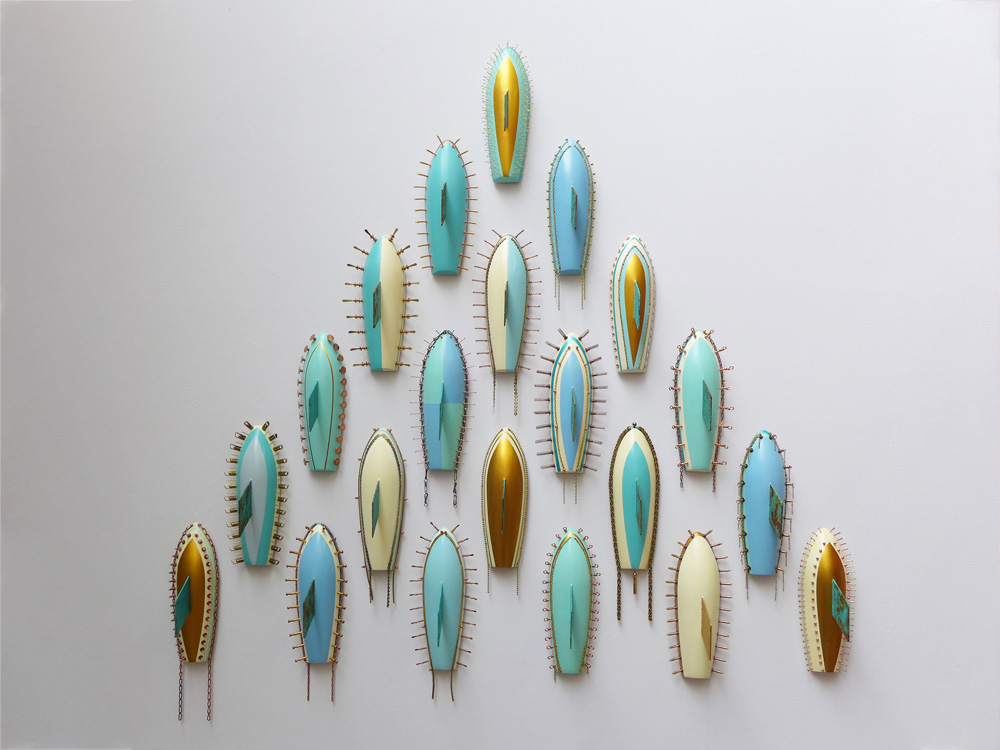
'All that Glistens' No.1 - 21

Pomp and Circumstance, Wood and metal. Presented by October Gallery. ENQUIRE.
You’ve also spoken about some of the works just being fun. That it’s important to have humour. Can you tell me more about how you use humour?
I think it’s just always been present in my life. I grew up as the only Black person in the village. And if you haven’t got a sense of humour then, woah! Yeah I think it’s just something that’s always been part of my personality. And I can see the humour in things, there’s no reason why that’s not going to come through in what I make. So yeah you can have a laugh too. Some of the pieces are quite comical but it doesn’t mean they’re not beautiful or political or challenging.
They can contain multitudes.
Yeah. It’s interesting to me as well, once you’ve handed over a piece of art to a gallery then other people bring all their stuff to it. And there’s a point where you start to get lost between what you’ve said and what they’ve said because it’s all relevant.
I had the most hilarious thing happen. When I had my sell out show at 1:54 I had a whole series of women in their forties, not talking to me but looking at me knowing I’m the artist and winking because of course what they saw was giant vaginas. And then it becomes vagina dentata with all the spikes. I just couldn’t stop laughing, I thought that was perfect.
Yes! That is so good.
Just a wink, I loved it.
I love that there are strong visual clues in your work of all the things you’ve done before: jewellery design, set design, furniture.
Yeah, that’s very satisfying for me to bring all the skills together and of course it also ties in with the fact that my father was a design engineer so he was always making. Making’s always been around me so I’ve always felt confident in it. And then becoming a set designer. I was initially a prop maker and then I moved my way up because I could do technical drawing. So I saw stuff made. I worked on the MTV Awards for years as the art director so I saw giant sets being made. I worked on the Commonwealth Games. And then having done the jewellery in my twenties. All those skills come together.
It’s amazing, it shows a whole lifetime of craft.
Yeah I mean I felt very anxious about making people aware that I’d had another career but I am the result of my past so there’s no point hiding it. And you know, you’re the first person who’s said that, but once you know that it’s so obvious.
In your latest works, All that Glistens and Heavy Is The Head That Wears The Crown what was the idea behind presenting the hulls together as a flotilla?
Well basically my hull dealer rang me up and said I have 50 little hulls here, do you want them? And I went, yeah! God they were in a mess, they were dirty, dented, keelless. Anyway I fixed them up and was looking at them on the floor and suddenly realised, my god, it’s a flotilla, of course it is. I made one flotilla that’s sold as one piece of 21 hulls and one that can be sold separately.
Is there anything else you’re working on that’s in development?
Yes, I’m working on a woman sculpture called Dynamo. She’s a powerful force of nature. And she’s defending the land on a beach front. That’s where she belongs. And we know that interesting things in life happen on the edge of things, on the borders of things and the beach is the perfect borderland. And women traditionally occupy that space, you know mermaids, fisherwomen, loads of myths: Yemoja, the goddess of the rivers from Nigeria. These women should act as reminders of the powerful force of nature and how we have to work with it and not against it. Static, she’s a protector, but should she turn to life and start whirling round then she’s a highly destructive force. In my mind it’s a recognition that we need to be constantly aware of climate change. And the powerful force of nature, and the fact, of course, that she is a woman.
I’ve got Superhero Cog Woman going into a show in Kensington for the summer, in Holland Park. She has six other sisters. She’s basically adaptable, like women are, she’s made of components. So if I switch the components round I can get a different figure.
Would you like to see her in a permanent place?
Oh my god. I want her and all her sisters, nieces, aunts all together dancing. Because they’re cogs they go together and they move around each other. That’s the suggestion. They’re in a dance. But don’t forget they are superheroes so they are about to spin off at any moment and do something wonderful. That’s what superheroes do isn’t it?
Yes, save the world!
Yeah!
And how wonderful to have that as a statue in the central part of a city.
It would be wonderful.
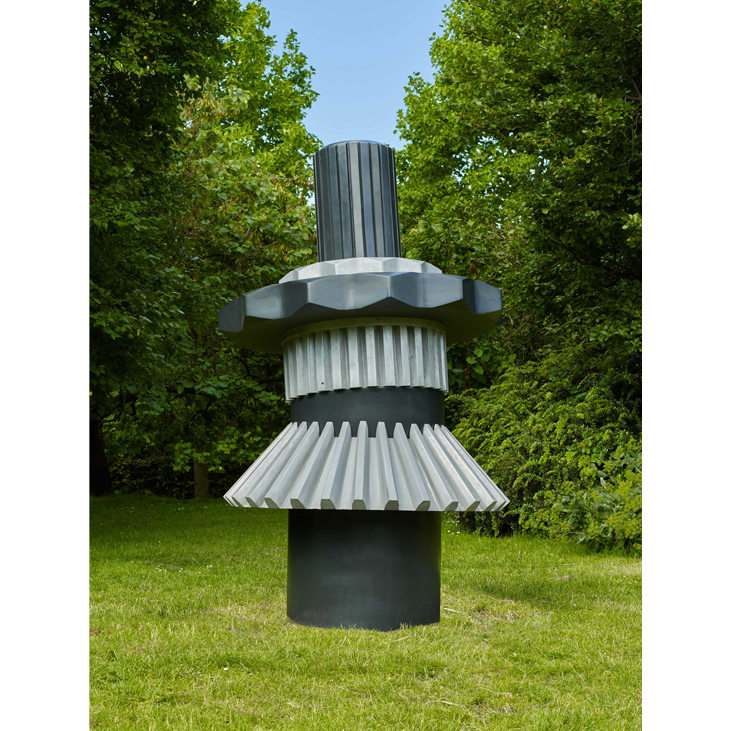
Superhero Cog Woman #01, 2019. Edition of 7, Jesmonite and steel.
Interview by Alix-Rose Cowie
Further Reading In Articles
African Artist Directory

